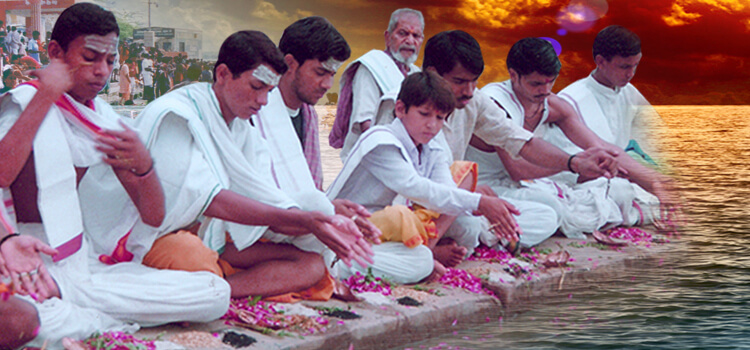The popular festival of Kartik Purnima is also called Tripurari Purnima or Deva Diwali. It is the ‘festival of lights’ of the gods and is celebrated on the full moon day (Purnima) in the month of Kartik (November – December), one of the most auspicious months of the year. The festival is held in honor of Lord Vishnu and Lord Shiva. It is believed that on this day, all the gods come down to earth and enter the sacred rivers like the Ganges, Yamuna, Narmada, Krishna and Godavari. Devotees celebrate the festival by taking a bath in the rivers and performing special Poojas on the banks of these sacred rivers. The ceremonies of ‘Deep Daan’ (floating lamps on the rivers) and Tulsi Vivah (marriage of goddess Tulsi with Vishnu) are also performed.
Legends About Kartik Purnima
Kartik Purnima honors lord Vishnu who incarnated as the Matsya avatar on this day. It is believed to be his first incarnation. Taking the form of a huge fish, he rescued all creatures, including Manu, the first man, from a great deluge. According to another legend, Lord Shiva slew the demon king, Tripurasara on the same day. The demon had acquired great powers by worshipping Brahma. Soon, he became arrogant and began misusing his newly acquired powers to torment those who inhabited the three worlds. Even the devas could not control him. Finally he conquered the world and created three cities called Tripura. In a panic, the Devas ran to Lord Shiva and beseeched him to destroy the demon. Shiva agreed. He killed the demon and destroyed the three cities with just one arrow. To celebrate the occasion, the overjoyed devas lit ‘diyas’ (lamps) in heaven. Hence the festival is also called Deva Diwali. It also happens to be the birthday of Vrinda who was the personification of the tulsi plant and Kartikeya, the god of war. Some believe that Krishna and Radha danced the Raas lila on this day.
Kartik Purnima Fasting
A 24-hour fast is observed on the day, beginning in the morning after taking bath, and ends the next morning. After performing a Pooja to Shiva or Vishnu, the fast may be broken. Food or water is not taken during this time but the elderly might have water, milk or fruits. Cooked food is prohibited.

Rituals of Kartik Purnima
Devotees have ‘kartik snana (bath)’ in the rivers on this day. Bathing in the sacred waters of the Ganges is very auspicious. In Varanasi, people light lamps in their houses and on the banks of the Ganges river. Thousands of lighted diyas glimmering in the gathering dusk all around the famous ghats makes for a grand visual spectacle. The lights in the water and near trees are believed to grant salvation to fishes, birds and insects.
People visit Shiva temples and light lamps near the Shiva lingam. Rudra Abishekam is performed on the occasion and the Shiva lingam is bathed with milk and honey. Lamps are given as gifts to priests. Fasting is undertaken for 24 hours and idols of Shiva are carried in big processions. Devotees place 360 or 720 wicks in temples to get moksha. In importance, Tripuri Purnima is second only to Maha Shivaratri.
The last five days of the Kartik month are very sacred and they are called ‘panchaka’ of which the last day is the Kartik Purnima. During this time devotees take food only once in the afternoon. This is called Habisha. Many people prepare wheat halwa (sweet) for the Pooja at home. It’s made with wheat flour, ghee, sugar, cardamom powder and raisins.
The day is ideal for performing the Satyanarayana Pooja or fasting. Diyas are often placed near Tulsi plants and Amla trees to honor Vishnu. Devotees visit temples and offer food to the gods. The prasad is called ‘annakoot’. Devotees should not commit acts of violence on this day, like shaving, cutting hair, plucking flowers and fruits, cutting trees and crops, and even sex.
Benefits of Kartik Purnima Rituals
The day is dedicated to Pitrs or dead ancestors. It is even more special if the day falls under Krithika Nakshatra when it is called Maha Kartik. Performing Pooja, Tapa, Daan, Japa and yagna on this day brings wonderful results. It is also believed that those who worship Lord Shiva on this day will be able to achieve the four main aims of life – Dharma, Artha, Kama and Moksha. It is a good day for performing acts of charity. Brahmins are fed and cows donated. The day is closely associated with Prabodhini Ekadasi which marks the end of a four-month period when Vishnu goes to sleep. On Prabodhini Ekadasi day, Vishnu wakes up from sleep. Several famous fairs like the Pushkar fair and the Pandarpur fair begin on Prabodhini Ekadasi and end on Kartik Purnima. Donations made on this occasion will earn merit equivalent to performing 100 Ashwamedha yagas.



Your article helped me a lot, is there any more related content? Thanks!
Thanks for sharing. I read many of your blog posts, cool, your blog is very good.